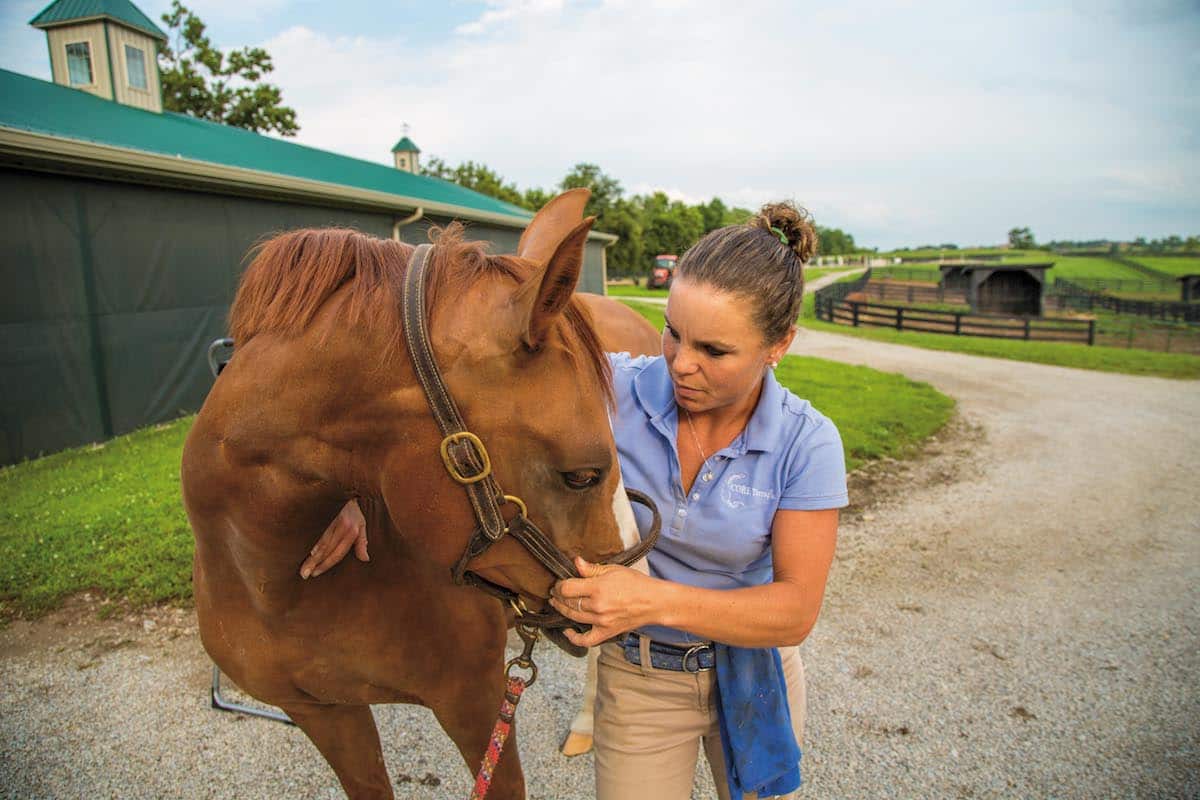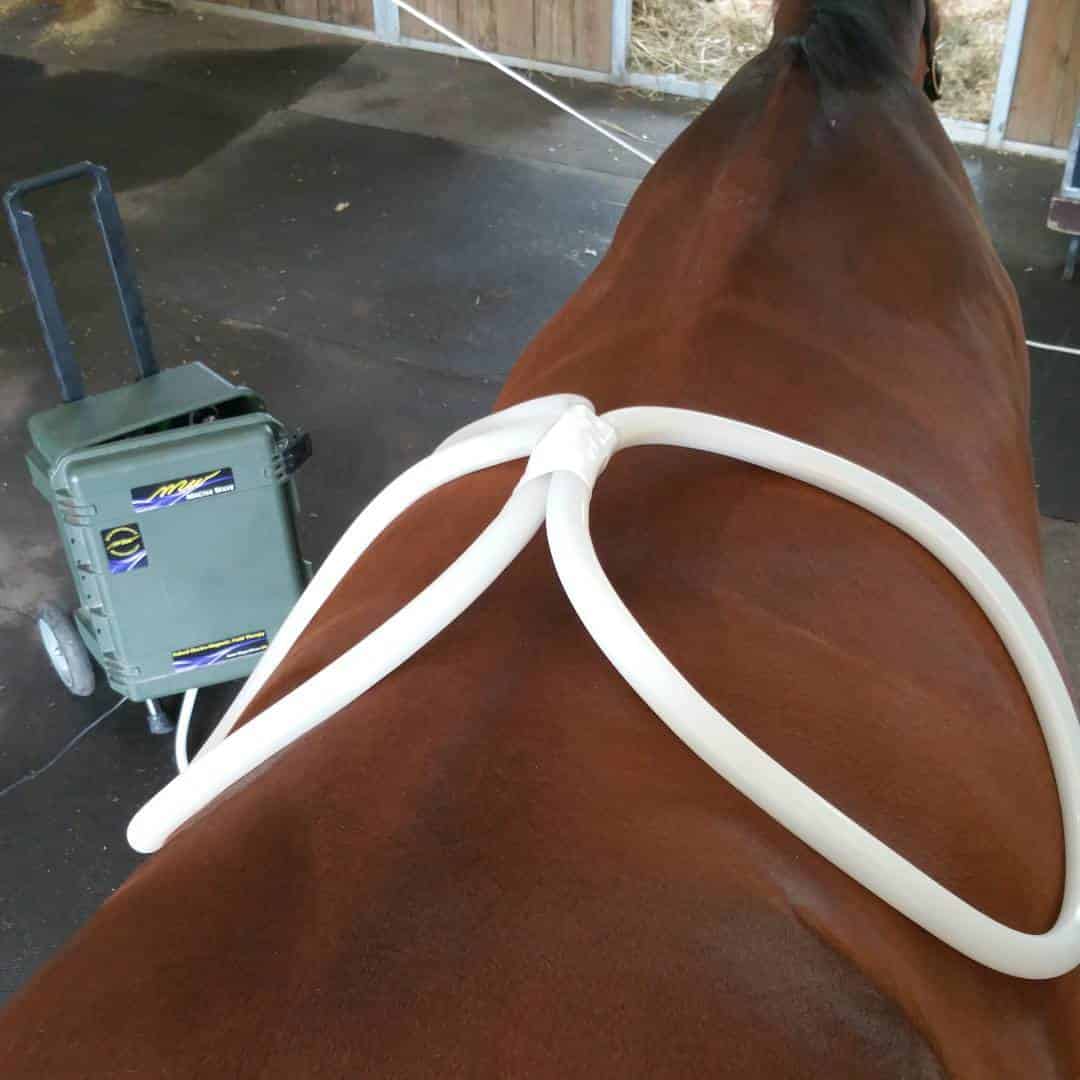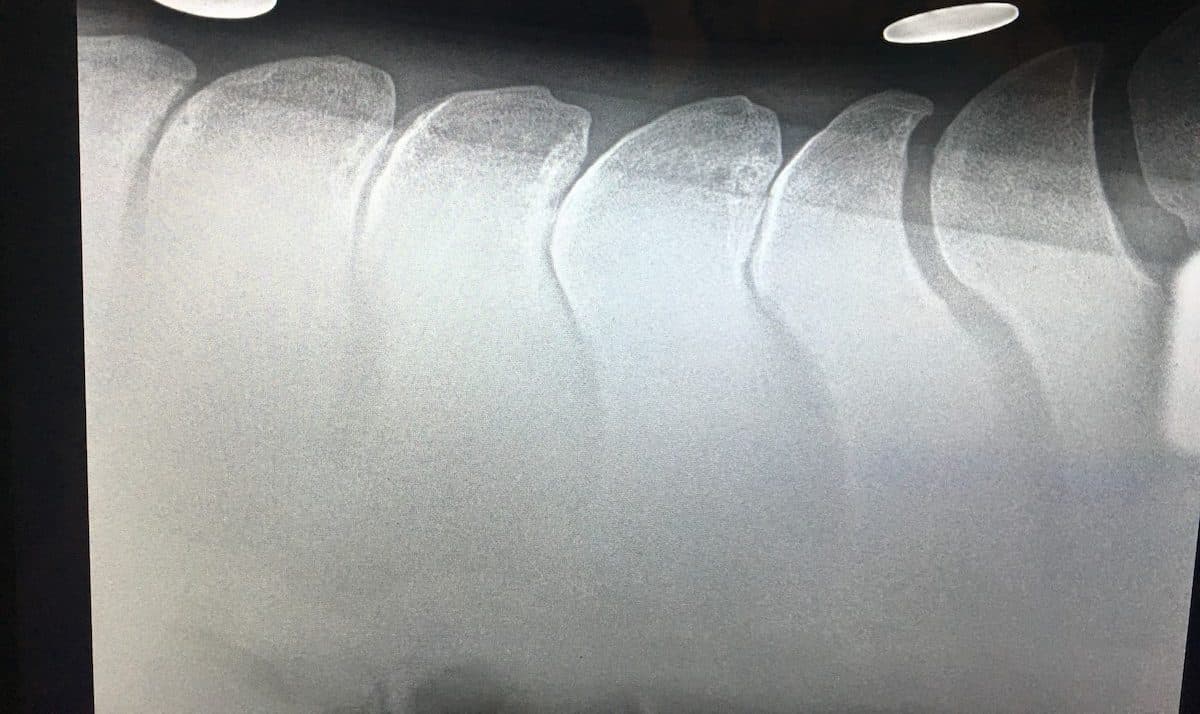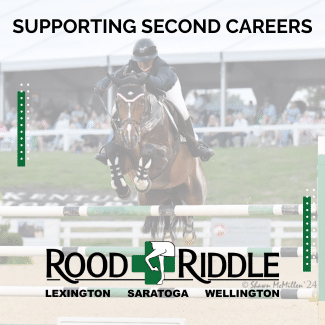Some Thoroughbreds come off the track with tight or painful backs

Chiropractor examining a horse, August 2013
Photo by: Kevin Thompson
Your horse’s back is more than just a place to sit. It’s a complex structure that impacts how efficiently he moves, whether he’s sound and if he’s comfortable while working. But, like any other part of the horse’s musculoskeletal system, it’s subject to tightness, discomfort and injury, all of which can have a significant impact on a horse’s performance.
Off-track Thoroughbreds’ (OTTBs) backs are no exception. So to help you start your new OTTB off on the right foot or to keep your current horse’s back healthy, we’ve consulted a veterinarian who has extensive experience working with OTTBs, along with representatives from two Thoroughbred aftercare and adoption facilities, to find out why back health is important, how to treat issues and how to maintain a healthy back.
Larkspur Carroll, DVM, owner of CORE Therapies, The Veterinary Acupuncture and Chiropractic Clinic, in Versailles, Kentucky; Lisa Molloy, executive director of ReRun Inc., a nonprofit Thoroughbred adoption program in East Greenbush, New York; and Caroline Betts, president of Southern California Thoroughbred Rescue (SCTR), a Norco-based nonprofit that rehabilitates, retrains and rehomes retired Thoroughbred racehorses, share their experience and insight to help keep your horse (and his back) on the right track.
The Thoroughbred’s Back
Take a look at advertisements for OTTBs coming off the track. Among other details, many state what the horse’s career looked like (“a war horse that made 55 starts and earned $200,000” or “showed little interest in racing”) and what his soundness status is (“retiring sound with clean legs” or “needs time off for a knee chip to heal but has a good prognosis for returning to soundness”).
While those details are important for evaluating soundness and future potential, so is the horse’s back condition … and not many ads describe that. Some horses retire with a healthy back, while others experience issues such as tightness or pain.
Carroll says a variety of factors play into back soundness, including limb and body conformation, length and extent of career, previous husbandry practices and training surface.
“So on one end of the spectrum you may have a horse that races in the upper-echelon circuits, trains at a training center where there are turnout options, … various forgiving surfaces where the horse can be trained in a balanced manner (and) access to therapy options (vibration plates, spas, chiropractic and acupuncture care), whom is lightly raced and retired sound,” she says.
“The other end of the spectrum — the more common scenario — is the horse that’s retired from the middle- to lower-scaled racing tier, stall-bound multiple hours per day, heavily raced with less time between races, trained mostly counterclockwise and with varied conditioning practices,” says Carroll. And you might find these are the horses most likely to have previous injury because of those practices.
Carroll says previous injury to the horse’s lower limbs or otherwise can also impact his back. “The body will develop compensations throughout the topline and contralateral limbs to support the injury,” she says, referring to limbs on the side opposite to the injured one. “This can certainly contribute to tightness if left uncorrected.”
And, of course, unaddressed back pain or injury can also impact long-term performance. “For instance,” Carroll says, “sacroiliac or hip discomfort in a right hind limb may contribute to an overload soft tissue injury to a left front limb. And even if the specific injury is healed with time, the compensations can cause asymmetric loading patterns and overload injuries in the future.”
With all this in mind, take steps to “soften” and strengthen your OTTB’s back when he comes off the track to help his body prepare for — and excel in — his second career.
“Balance and suppleness are not inherent components of a Thoroughbred’s early training regime,” Carroll says. “Yet, they are extremely important to overall health and success in the other disciplines. Stretching, softening and maintaining full range of motion to all joints contributes to long-term health and well-being of joints and helps maintain high performance and soundness.”
Where Do I Start?
You might already suspect your horse has a tight or painful back. Maybe you’ve observed him flinching when you touch his back, hollowing it when you mount or becoming stiff and not striding out. Or perhaps you’ve noticed other issues, some of which can masquerade as behavior problems, that could actually be caused by back discomfort, which Carroll says can include:
■ Sensitivity to grooming;
■ Resistance or fussing when standing for the farrier;
■ Asymmetric gait patterns on different diagonals or canter leads;
■ Difficulty bending or balancing, especially to one direction;
■ Head-tossing;
■ Backing up to the wall or a corner post in a stall or when tied;
■ Piling up bedding and standing on the mound; and
■ Difficulty engaging under saddle, even for short periods of time.
Whether you think there’s a problem brewing or not, always have a veterinarian thoroughly evaluate your horse and his health to identify what physical issues you’re dealing with.
Some OTTBs arrive at their first post-career homes with complete medical histories, while others come with little to no health history. Regardless of the background, a comprehensive physical examination and radiographic and/or ultrasound evaluation give the veterinarian a chance to assess any old injuries.
He or she will be able to determine whether your horse’s back might be tight or otherwise uncomfortable. Many OTTB owners report dealing with tight or sore backs, but both Molloy and Betts indicate that back pain isn’t a problem they encounter frequently.
“Surprisingly very few (horses come in with back pain), as trainers are much more aware of whole body care and routinely utilize therapies including hyperbaric, swimming, chiropractic and acupuncture,” Molloy says. Rather, she’s found that horses are more likely to be body sore in general than acutely painful in one specific area of the back.
And she says it’s been her experience that when back pain is present, it’s sometimes rooted in hock and other hind-end issues.
Betts gives an example of a case from SCTR in which a horse appeared to have discomfort in his back. “In fact, he had arthritic hocks, and his stance and discomfort arose because he was trying not to bear weight on them,” she says. “We have had his hocks injected, and that discomfort is already resolved.”
Carroll says she’s found it beneficial to treat back issues that developed due to joint and other issues, as well. “If the abnormal tracking and compensations (resulting in back discomfort) aren’t corrected in conjunction with lower limb treatments, the abnormal tracking remains for a period and negatively feedbacks what you just treated. … No one wants to just ‘Band-Aid’ the leaky hose. You want an efficient patch that will sustain long-term wear and tear.”
And when true back issues do arise, it’s never too early to begin addressing them. “Ideally, a horse is assessed and adjusted before any period of layup or let-down,” says Carroll. “The horse’s body will be able to (recuperate) in a balanced frame as opposed to trying to correct the imbalances after the fact or in the face of training and muscle developments.”
She notes that traditionally veterinarians have used a variety of medical therapies to help relieve back pain from tension, including:
■ Muscle relaxers, such as methocarbamol (Robaxin);
■ Anti-inflammatory drugs, such as flunixin meglumine (Banamine);
■ Mesotherapy (multiple intradermal — in the skin — injections over the back, croup and withers);
■ Shock wave therapy; and
■ Local injections.
Today, veterinarians also have a variety of noninvasive and complementary options at their disposal, she says, such as:
■ Chiropractic;
■ Acupuncture;
■ Photobiomodulation (Class IV laser therapy);
■ Pulsed electromagnetic therapy (PEMF); and
■ Various types of massage.
Many of these therapies have become very popular among horse owners and veterinarians alike and, while not all are yet backed by scientific research, many individuals believe they do help relieve pain and improve back health. Carroll, for instance, has found success using chiropractic care and acupuncture to improve many OTTBs’ back health and performance.
“More often than not I am adjusting and providing the other supportive alternative care simultaneously with more invasive techniques that a general practitioner does to more quickly and more effectively interrupt the abnormal patterns and disease process for more effective overall treatment and to extend the effectiveness of those invasive treatments, because those are what we want to be able to decrease,” she says.
In her experience, Molloy says horses diagnosed with back pain generally start with a veterinarian-prescribed short course of non-steroidal anti-inflammatory drugs and muscle relaxers, followed by injection of the region if the horse doesn’t improve significantly.
She also uses a variety of complementary therapies in conjunction with medical treatments, including daily vibration therapy sessions on a TheraPlate, cold laser, chiropractic and acupuncture. “I personally am rather fond of cold laser and Equi-Tape (elastic kinesiology tape designed for horses) — a combination we have had significant success with (that is) relatively nonintrusive for horses already making a stressful transition into a new world.”

Pulsed electromagnetic therapy is one of several noninvasive complementary therapies used on horses’ backs. Courtesy Magnawave
Soften the Back, Soften the Mind
While back issues can take time to resolve, don’t think of it as wasted time. Rather, take that opportunity to “soften” the horse’s mind — a crucial part of transitioning an OTTB successfully to life off the track and on the farm.
Molloy says introducing horses to turnout is an important part of “hitting the reset button. Horses are not started back under saddle until the horse is content in its turnout situation and settled in the barn routine, eating well, gaining weight and the angles of the feet have been addressed in a satisfactory manner. This can take anywhere from a few weeks to several months.”
Once those concerns are addressed, she says, the horses are started back to work slowly and moved along as their bodies and minds allow.
“Holding true to this formula we have had great success producing happy horses that are sound, in good flesh and with positive attitudes and wonderful hair coats. Less really is more,” she says. “A mentally and physically rested horse will listen more acutely, perform at a consistently higher level and progress quicker when they start the process of transitioning than one that has not had those needs addressed.
“The supporting structures of the horse’s body need to be able to … adapt to the new increased workload, along with the new enhanced way of carrying oneself, as failure of these will result in aggravated prior injuries or the increased chance of newer injuries,” she adds.
Maintaining a Healthy Back
Once your horse has gotten the veterinarian’s stamp of approval to start retraining, take steps to keep his back healthy as he begins his new career, even if his back was in relatively good shape to begin with.
“A correctly fitting saddle is essential, as is mounting technique to reduce torque on the back, in conjunction with rider balance and straightness in the saddle,” Molloy says.
Carroll agrees, adding that proper warm-up and conditioning techniques are essential to maintaining a healthy back. She also recommends owners use passive stretching — you might know this better as carrot stretches — to help horses stay limber and improve flexibility.
Carroll says each horse’s unique maintenance regimen depends on factors such as the horse’s starting point (a horse with a very painful back likely needs more frequent attention than one with transient muscle tightness) and his workload and future performance goals (a horse that hacks around the farm and goes to a few small shows probably needs less frequent treatments than an upper-level prospect or athlete that’s in intense training and competing regularly).
Your veterinarian is equipped to recommend a treatment schedule for your horse, which might even change over time. As a horse’s back muscles get stronger through work, he might need fewer pain-relieving treatments.
In the meantime, Carroll says owners can watch for signs of back soreness, either due to primary back issues or secondary issues caused by other ailments. If your horse displays such signs as the ones we’ve described, it’s worth calling the veterinarian to determine their cause.
The Bottom Line
“The mechanics of the horse’s back affect efficiency and soundness of movement,” Carroll says. “Poor back conformation and health can contribute to or even cause limb lameness. Poor performance, discomfort and unsoundness result.”
As such, it’s important to keep tabs on your OTTB’s back as he transitions to a new career and advances up the levels. In addition, look at the whole picture.
“I think people put too much focus on specific areas, such as the back or tendons, when the emphasis should be the overall condition and health of the horse,” Molloy says. “We keep our regime extremely simple and incorporate cutting-edge veterinary care into time-honored, tried and tested stable husbandry. We frequently see horses with knee issues that are more related to the front feet and back issues which correlate to the hocks — the whole picture is essential.”
Specific Injuries
Kissing spines occurs when the vertebrae’s dorsal spinous processes touch. Courtesy The Horse Staff
In some cases, you’ll be faced with a complex back problem that requires more than rest, body work and your traditional anti-inflammatories and joint injections. A few examples of these more diagnostic- and treatment-intensive cases include:
Kissing spines This condition occurs when the vertebrae’s dorsal spinous processes are spaced too closely or touch. While many affected horses exhibit signs of back pain, some show no signs of discomfort or diminished performance. Veterinarians can use radiography to diagnose the condition and can recommend the best treatment option, such as corticosteroid injections or surgical correction.
Osteoarthritis One of the most common causes of lameness in horses, osteoarthritis can also develop in the joints along the horse’s spine. This progressive condition occurs when the joint cartilage breaks down, and it leads to pain, stiffness and inflammation. At this point, cartilage damage can’t be reversed, but certain veterinarian-prescribed treatments can help relieve your horse’s discomfort.
Scoliosis While this condition is often congenital, meaning it’s present from birth, it can also be acquired. When muscles around the spine try to protect an injured or nonfunctional area by contracting, the spine can actually take on the “S” shape seen with congenital scoliosis. And while congenital scoliosis isn’t always painful, the acquired condition often is. Acquired scoliosis tends to get worse with time, especially when the inciting cause is left untreated. Not much can be done about the congenital form, but acquired scoliosis can be remedied in some cases.
Soft tissue injury The muscles and ligaments that support your horse’s back can become inflamed, strained or otherwise injured for a variety of reasons. What’s more, your horse might try to compensate for or relieve the soft tissue pain by moving other parts of his body abnormally, potentially leading to additional injury and making diagnosis challenging due to the compounding problems.
Vertebral fracture These are common in horses that have fallen, flipped backward or otherwise suffered trauma to the spine. Some fractures are obvious — especially if the withers are deformed in the fall — but others might not be; some horses only show subtle signs of a problem, such as mild discomfort, forelimb lameness or reluctance to move their head and neck. Your veterinarian will typically use imaging to diagnose vertebral fractures. Many such injuries can be treated successfully, sometimes with conservative methods like stall rest and anti-inflammatories and other times with surgery.
Remember that some back problems will limit or end a horse’s athletic career. Work with your veterinarian to diagnose and treat issues that arise to ensure your horse has the best chance possible to return to work.


